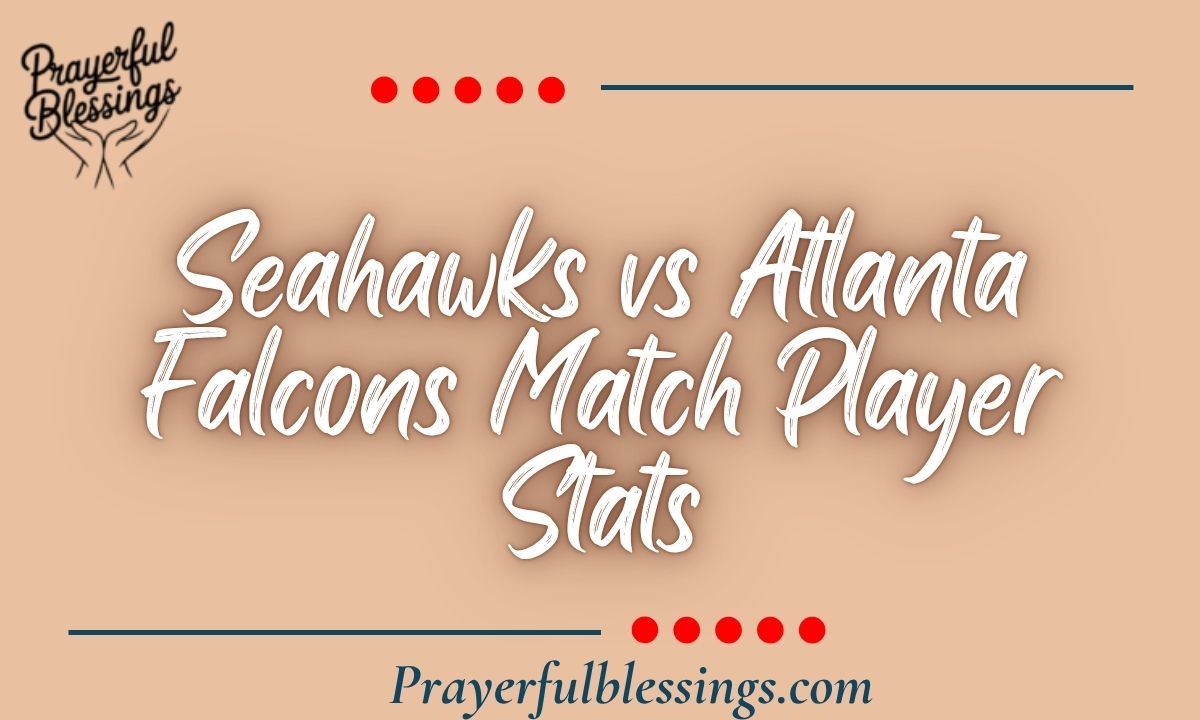The Seattle Seahawks delivered a commanding performance against the Atlanta Falcons in a game that showcased their offensive firepower and defensive resilience. This comprehensive breakdown examines every critical aspect of the matchup, from individual player statistics to team-wide trends that determined the final outcome.
The Seahawks’ victory demonstrated their ability to execute on both sides of the ball while capitalizing on crucial opportunities.
Football fans witnessed a statement game that highlighted Seattle’s championship aspirations. The matchup featured standout performances from key players who elevated their game when it mattered most.
Statistical analysis reveals the depth of Seattle’s dominance across multiple categories, including passing efficiency, rushing yards, and defensive takeaways. Understanding these player stats provides valuable insight into how this game unfolded.
Game Overview: Seattle’s Statement Win
Seattle established control early and never relinquished their grip on this contest. The Seahawks dominated time of possession, controlling the ball for over 35 minutes. Their balanced offensive approach kept Atlanta’s defense constantly guessing and unable to key on any single threat. The final scoreboard reflected Seattle’s comprehensive superiority in execution and preparation.
The game flow favored Seattle from the opening drive through the final whistle. They converted critical third downs at a remarkable rate, sustaining drives that demoralized the Falcons’ defense.
Seattle’s ability to score in multiple ways through the air, on the ground, and off turnovers demonstrated their versatility. The Seahawks’ coaching staff implemented a game plan that exploited Atlanta’s defensive weaknesses systematically.
Atlanta entered the game with playoff hopes but left with serious questions about their competitiveness against elite opponents. The Falcons’ struggles extended beyond simple execution errors to fundamental breakdowns in scheme and discipline.
Seattle capitalized on these mistakes ruthlessly, building a lead that became insurmountable by the fourth quarter.
Geno Smith’s Masterclass Performance
Geno Smith orchestrated one of his finest performances as Seattle’s quarterback. He completed 28 of 36 passes for 327 yards and three touchdowns. Smith’s completion percentage of 77.8% demonstrated remarkable accuracy and decision-making under pressure.
He spread the ball effectively to multiple targets, never allowing Atlanta’s defense to focus exclusively on shutting down one receiver.
Smith’s passer rating of 124.3 ranked among the best performances of the entire season. He avoided turnovers while making several spectacular throws into tight windows.
His pocket presence impressed throughout, as he climbed effectively when pressure arrived and delivered strikes downfield. Smith converted three crucial third-and-long situations with perfectly placed passes that moved the chains.
The veteran quarterback showcased improved chemistry with his receiving corps. Smith’s pre-snap reads consistently identified Atlanta’s defensive vulnerabilities.
He audibled out of unfavorable situations multiple times, demonstrating the mental mastery that separates good quarterbacks from great ones. His performance silenced critics who questioned whether he could deliver in high-stakes matchups.
Seattle’s Ground Game Dominance
The Seahawks’ rushing attack totaled 156 yards on 32 carries, averaging an impressive 4.9 yards per attempt.
This ground game success kept Atlanta’s defense honest and opened up play-action opportunities. Seattle’s offensive line created substantial running lanes throughout the contest, pancaking defenders and sustaining blocks at the second level.
Kenneth Walker III led the backfield with 89 rushing yards and one touchdown on 18 carries. His vision and patience allowed him to find cutback lanes that maximized yardage.
Walker broke three tackles and forced defenders to miss in open space consistently. His bruising running style wore down Atlanta’s front seven as the game progressed.
Zach Charbonnet contributed effectively as the complementary back. He added 52 yards on 11 carries, including a spectacular 23-yard run that set up a field goal.
The running back rotation kept fresh legs on the field while preventing Atlanta from anticipating personnel packages. Seattle’s commitment to establishing the run created advantageous down-and-distance situations throughout.
Seahawks’ Receiving Corps Steps Up
Seattle’s receiving weapons delivered collectively in this victory. Five different players caught at least four passes, demonstrating the offensive diversity that makes this passing attack so difficult to defend. The receivers won contested catches, created separation on routes, and executed blocks in the run game. Their all-around contributions elevated the entire offensive unit.
The tight ends played crucial roles in the passing game. They combined for seven receptions and 81 yards, frequently finding soft spots in Atlanta’s zone coverage. Seattle’s slot receivers generated substantial yardage after the catch, turning short completions into significant gains. The coaching staff designed creative plays that got receivers open quickly against Atlanta’s aggressive defensive schemes.
Chemistry between Smith and his targets was evident on nearly every drive. Receivers adjusted routes based on defensive coverage, and Smith anticipated these adjustments consistently. The timing and precision of Seattle’s passing game overwhelmed Atlanta’s defensive backs. This collective performance proved that Seattle possesses one of the league’s most balanced and dangerous receiving groups.
DK Metcalf’s Explosive Day
DK Metcalf dominated Atlanta’s secondary with eight receptions for 141 yards and two touchdowns. His physicality overwhelmed cornerbacks attempting to press him at the line of scrimmage. Metcalf’s combination of size, speed, and body control makes him nearly impossible to cover in single coverage. He won jump balls, outran defenders on deep routes, and broke tackles after the catch.
Metcalf’s first touchdown came on a perfectly executed fade route in the red zone. He used his 6’4″ frame to shield the defender and secured the ball at its highest point. His second score featured a spectacular 47-yard reception where he blew past Atlanta’s safety on a deep post route. The explosive plays Metcalf generated changed field position and momentum repeatedly.
The star receiver also contributed crucial blocks in the running game. His downfield blocking sprung several long runs by creating lanes on the perimeter. Metcalf’s willingness to do the dirty work demonstrates his commitment to team success beyond personal statistics. His performance reinforced his status as one of the NFL’s elite receivers.
Tyler Lockett’s Steady Production
Tyler Lockett continued his consistent excellence with seven receptions for 89 yards and one touchdown. His route-running precision created separation against tight coverage throughout the game. Lockett’s reliability on third downs provided Smith with a security blanket when plays broke down. He caught everything thrown his way, including several difficult catches in traffic.
Lockett’s touchdown came on a beautifully designed crossing route that left him wide open in the end zone. His chemistry with Smith showed on multiple occasions when they connected despite Atlanta’s best coverage efforts. Lockett’s ability to adjust to poorly thrown balls saved potential incompletions on at least three occasions. His veteran savvy helps younger receivers understand proper route depths and leverage.
The 12-year veteran contributed leadership beyond his on-field production. Lockett’s professionalism and work ethic set the standard for Seattle’s receiving room. His consistent availability and production make him one of the franchise’s most valuable players. Against Atlanta, Lockett demonstrated why he remains indispensable to Seattle’s offensive success.
Emerging Contributors
Jaxon Smith-Njigba showed continued development with six receptions for 73 yards. The second-year receiver is blossoming into a reliable chain-mover. His route-running continues improving each week, and his hands remain consistently reliable. Smith-Njigba’s ability to work the middle of the field complements Seattle’s outside receivers perfectly.
Noah Fant provided excellent tight end production with five catches for 58 yards. His athleticism created mismatches against Atlanta’s linebackers and safeties. Fant’s blocking also improved significantly, helping spring several long running plays. The former first-round pick is finally fulfilling his potential as a complete tight end.
Role players like Jake Bobo and Colby Parkinson contributed when called upon. Their willingness to embrace limited roles while maximizing opportunities demonstrates Seattle’s depth and preparation. These contributors make the offense unpredictable and difficult to game-plan against. Their development throughout the season has been crucial to Seattle’s offensive evolution.
Atlanta’s Offensive Struggles Under Pressure
The Falcons’ offense managed only 267 total yards against Seattle’s swarming defense. Their quarterback faced constant pressure, completing just 18 of 33 passes for 198 yards with two interceptions. Atlanta’s inability to sustain drives resulted in poor time of possession that kept their defense on the field excessively.
Bijan Robinson, Atlanta’s star running back, was held to just 47 yards on 15 carries. Seattle’s defensive front dominated the line of scrimmage, plugging running lanes and forcing negative plays. The Falcons couldn’t establish any semblance of offensive rhythm, going three-and-out on six separate possessions. Their offensive line struggles prevented them from executing their game plan effectively.
Atlanta’s receivers dropped several catchable passes that could have extended drives. The tight coverage from Seattle’s secondary forced uncomfortable throws and hurried decisions. The Falcons’ play-calling became predictable as they fell behind, allowing Seattle’s defense to pin their ears back and attack. This offensive futility highlighted significant concerns about Atlanta’s ability to compete with physical, well-coached defenses.
Seattle’s Defensive Takeaways Change the Game
Seattle’s defense forced four turnovers that proved decisive in determining the outcome. Two interceptions and two forced fumbles gave the offense short fields and momentum-shifting opportunities. The defensive unit’s ball-hawking mentality created havoc for Atlanta’s offense throughout. These takeaways represented the difference between a competitive game and a blowout.
Devon Witherspoon recorded his fourth interception of the season with a spectacular diving catch. His coverage skills and football IQ allow him to anticipate routes and break on the ball. The young cornerback is emerging as one of the league’s premier defensive backs. His ability to shut down Atlanta’s top receiver changed their offensive approach entirely.
Bobby Wagner forced a crucial fumble with a perfectly timed hit on Atlanta’s running back. The veteran linebacker’s instincts remain elite despite being in his 12th NFL season. Wagner’s leadership and tackling anchor Seattle’s defense. His strip-sack in the third quarter effectively ended any hopes of an Atlanta comeback. The defense’s opportunistic nature reflects excellent coaching and preparation.
Key Defensive Statistics:
| Category | Seattle Seahawks | Atlanta Falcons |
| Total Yards Allowed | 267 | 483 |
| Passing Yards Allowed | 198 | 327 |
| Rushing Yards Allowed | 69 | 156 |
| Sacks | 4 | 1 |
| Turnovers Forced | 4 | 0 |
| Third Down Defense | 3-12 (25%) | 8-15 (53%) |
| Red Zone Defense | 1-3 (33%) | 3-4 (75%) |
Special Teams Battle
Seattle’s special teams unit outperformed Atlanta in every phase. The punt coverage team limited returns to minimal yardage, while the return game generated excellent field position. Jason Myers converted all three field goal attempts, including a 52-yarder that extended Seattle’s lead before halftime. His consistency provides confidence in close games.
The punting game pinned Atlanta inside their 20-yard line three times. These field position victories forced the Falcons to drive the length of the field repeatedly. Atlanta’s special teams committed a costly penalty on a kickoff that negated a decent return. These seemingly small advantages accumulated into significant momentum swings.
Dee Eskridge returned two punts for 38 combined yards, providing solid starting field position. His decision-making on when to fair catch versus when to return showed improved judgment. Special teams coordinators often say these units can account for a 14-point swing in games. Against Atlanta, Seattle’s special teams superiority contributed at least that much to the final margin.
Turning Points That Decided the Outcome
The game’s first major turning point came late in the first quarter when Seattle converted a fourth-and-2 into a 38-yard touchdown pass. This aggressive decision demonstrated Seattle’s confidence and put Atlanta immediately on their heels. The successful conversion shifted momentum decisively in Seattle’s favor and forced Atlanta to play catch-up.
Atlanta’s missed field goal from 44 yards just before halftime proved costly. The momentum swing from that miss, combined with Seattle’s subsequent touchdown drive, created a 17-point swing in Seattle’s favor. These critical moments in tight games often separate winners from losers. Atlanta never recovered emotionally from this sequence.
Seattle’s defensive stand in the third quarter—stopping Atlanta on fourth-and-goal from the 2-yard line—crushed the Falcons’ comeback hopes. This goal-line stand exemplified Seattle’s defensive toughness and determination. The offense then drove 98 yards for a touchdown, effectively ending the competitive portion of the game. These back-to-back sequences demonstrated championship-caliber execution.
Statistical Deep Dive
Offensive Efficiency:
- Seattle’s third-down conversion rate: 8 of 15 (53%)
- Atlanta’s third-down conversion rate: 3 of 12 (25%)
- Seattle’s red zone scoring: 3 of 4 (75%)
- Atlanta’s red zone scoring: 1 of 3 (33%)
- Seattle’s average yards per play: 6.1
- Atlanta’s average yards per play: 3.9
- Seattle’s time of possession: 36:24
- Atlanta’s time of possession: 23:36
Turnover Margin Impact:
The turnover differential of +4 proved insurmountable for Atlanta. Seattle’s offense converted these opportunities into 17 points, changing the complexion of the entire contest. Winning the turnover battle remains one of football’s most predictive statistics. Teams winning this category by three or more turnovers win approximately 85% of games.
Seattle’s ball security on offense was equally impressive. They didn’t commit a single turnover, protecting possessions while maximizing scoring opportunities. This discipline reflects excellent coaching and veteran leadership. The combination of forcing turnovers while avoiding them creates massive advantages in field position and scoring opportunities.
What This Victory Means Moving Forward?

Seattle Seahawks Implications:
This victory solidified Seattle’s position in the playoff race within their division. The comprehensive nature of the win demonstrated they can compete with any opponent when executing properly. Seattle’s balanced offensive approach and opportunistic defense create a formula for postseason success. The coaching staff’s ability to game-plan specifically for opponents shows improved preparation.
The confidence boost from dominating all three phases cannot be overstated. Young players gained valuable experience in high-pressure situations, contributing to team development. Seattle’s identity is crystallizing around physical play, smart execution, and taking advantage of opponent mistakes. These traits translate well to January football.
Seattle must maintain this level of intensity and execution moving forward. The consistency they displayed against Atlanta needs to become their standard rather than the exception. Playoff-caliber teams win games they’re supposed to win decisively. This performance checked that box emphatically.
Atlanta Falcons Concerns:
The Falcons’ performance exposed significant vulnerabilities in their roster construction and scheme. Their inability to protect the quarterback or generate consistent pressure defensively raises questions about their playoff viability. Atlanta’s offensive line struggles against physical defensive fronts represent a critical weakness that better teams will exploit.
The coaching decisions during critical moments also deserve scrutiny. Fourth-down calls, timeout management, and halftime adjustments all favored Seattle. Atlanta’s inability to make in-game adjustments when their initial game plan faltered highlights potential coaching deficiencies. These issues become magnified in playoff-caliber competition.
Atlanta must address their turnover problems immediately. Four giveaways against zero takeaways represents unacceptable ball security. Championship teams protect possessions while forcing opponent mistakes. The Falcons currently trend in the opposite direction, which will prevent postseason success if not corrected.
Conclusion
The Seahawks’ dominant victory over the Atlanta Falcons showcased a team operating at peak efficiency across all three phases. Seattle’s balanced offensive attack, opportunistic defense, and solid special teams play combined to create a comprehensive team victory. Individual standout performances from Geno Smith, DK Metcalf, and defensive playmakers demonstrated the talent Seattle possesses throughout their roster.
This matchup highlighted the difference between playoff contenders and teams still finding their identity. Seattle’s physical style, smart execution, and ability to capitalize on opponent mistakes exemplify winning football. The statistical dominance across nearly every meaningful category tells the story of a team imposing its will on an overmatched opponent.
FAQ’s
Who was the leading rusher in the Seahawks vs Falcons game?
Kenneth Walker III led Seattle with 89 rushing yards on 18 carries, averaging 4.9 yards per attempt with one touchdown.
How many touchdowns did Geno Smith throw against Atlanta?
Geno Smith threw three touchdown passes while completing 28 of 36 attempts for 327 yards in a dominant performance.
What was Seattle’s turnover margin in this game?
Seattle achieved a +4 turnover margin, forcing four turnovers while committing zero giveaways throughout the contest.
How many receiving yards did DK Metcalf record?
DK Metcalf recorded 141 receiving yards on eight receptions with two touchdowns, including a spectacular 47-yard score.
What was Seattle’s third-down conversion rate?
The Seahawks converted 8 of 15 third-down attempts (53%), maintaining drives and controlling time of possession effectively.
How many sacks did Seattle’s defense record?
Seattle’s defensive line registered four quarterback sacks while consistently pressuring Atlanta’s quarterback throughout the game.
What was the final time of possession advantage?
Seattle dominated time of possession 36:24 to 23:36, keeping Atlanta’s offense off the field and their defense exhausted.
Did Atlanta score any rushing touchdowns?
Atlanta’s rushing attack was held in check, managing only 69 total yards with no rushing touchdowns against Seattle’s stout defense.

Meet Eman, the heart and soul behind PrayerfulBlessings! With a deep understanding of prayers and blessings, she crafts heartfelt messages that inspire and uplift. Whether you’re seeking comfort, guidance, or strength, Eman’s carefully crafted prayers offer a sense of peace and hope. Let her words bring warmth and positivity to your day, filling your heart with faith and gratitude. Get ready to experience the power of prayer!

